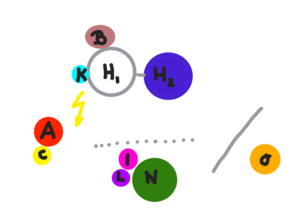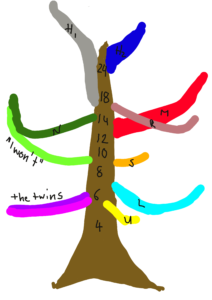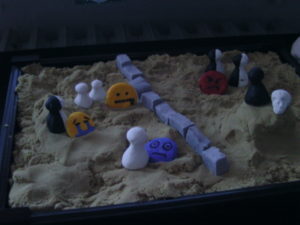Mapping is an exercise that is introduced early in DID/OSDD therapy. The goal is to create an overview that shows the different parts of the system in relation to each other. At first the maps will not be complete. They grow, as awareness grows and there will be a certain amount of guessing until we know for sure. Mapping is not a one-time event, it should be done regularly because things will change as our therapy progresses. That’s why it makes sense to date our maps and compare them every now and then.
There isn’t one right way to map a system. You can do it any way that fits you.
Maps could show
- the different parts
- their age or guesses about their developmental stage
- names, nicknames or some short way to describe them
- their role within the system or during trauma time
- how parts relate to each other
- skills certain parts have or lack
- habits concerning coping behavior
- core needs
- time spent fronting
- other crucial information
- ….
No map has to show all these things though. New understanding can be added later or you might create separate maps for a topic that you are working on in therapy.
I will show you a couple of ways mapping could be done. One isn’t better than the other, they differ in what is emphasized, so they can serve slightly different purposes.
Circles
Different parts can be painted as circles of different size and color, the distance between the circles indicating the relationships between parts.
Some use big circles for adults, medium circles for teens and small ones for younger parts. The color of a circle could stand for a certain role or for how much trauma a part knows. You could add a frame around a circle, a spot or star in the middle or colored patterns, just make your own legend and stick to the symbols you chose.

Some like to track who is fronting most by giving these parts bigger circles and others smaller ones. It can be interesting to observe changes in fronting behavior over time.
There are no rules here. Whatever you work on in therapy right now could become the main focus of a circle map. I would start out simple, with just roles or putting parts into relation to each other.
Some helpful questions could be
- What parts are known at this point?
- Who avoids whom?
- Who helps whom?
- Who tries to control or punish whom?
- Who takes responsibility?
- Who knows/doesn’t know trauma?
- Who is close/distant?
- Are there any groups of similar parts?
- Are there specific roles or jobs?
- Is communication or co-consciousness possible?
- ….
System Tree
 Parts can be represented by branches on a tree. The length, thickness, color and placement on the tree can differ. A tree can be a good way to show that parts are not independent, they are just divided from each other and share the same trunk and roots. Some use the trunk like a timeline, the lower branches represent the earliest parts; the higher up the more recent parts developed.
Parts can be represented by branches on a tree. The length, thickness, color and placement on the tree can differ. A tree can be a good way to show that parts are not independent, they are just divided from each other and share the same trunk and roots. Some use the trunk like a timeline, the lower branches represent the earliest parts; the higher up the more recent parts developed.
It is possible to show parts that split into different versions of the original as well as overlapping or fused parts. We can always add leafs or fruit to branches to represent whatever seems important or draw bridges between branches etc. Again, make it anything you want.
Symbolic items
 Parts can be shown as items that represent their characteristics, like figurines, things from nature or household items. It makes it easy to see who is e.g. softer or more resilient or scary. Once we have chosen items, they can be placed within a defined area to make relationships or conflict visible. We can use a sand tray or lego for this purpose, it offers a safe frame, or use the whole room with the floor, furniture, different corners, hiding places etc. With this technique we get to use 3 dimensions instead of just 2, which can help to map complex relationships and different layers of the system. A sand tray can be used frequently to make daily moods and challenges visible and can just sit on a counter to remind us to check on ourselves. It is a flexible way to include mapping into everyday life.
Parts can be shown as items that represent their characteristics, like figurines, things from nature or household items. It makes it easy to see who is e.g. softer or more resilient or scary. Once we have chosen items, they can be placed within a defined area to make relationships or conflict visible. We can use a sand tray or lego for this purpose, it offers a safe frame, or use the whole room with the floor, furniture, different corners, hiding places etc. With this technique we get to use 3 dimensions instead of just 2, which can help to map complex relationships and different layers of the system. A sand tray can be used frequently to make daily moods and challenges visible and can just sit on a counter to remind us to check on ourselves. It is a flexible way to include mapping into everyday life.
Maybe you don’t like working with pictures. Then you could try to use a little book where different parts could have their own pages with descriptions and everything that seems important. (More about a System (scrap)book)
We keep a list of parts with their most important information, like an overview of characters in a book, for times when we interact with new helpers. It is easier than trying to explain a detailed map.
Tricky!
The concept of mapping is simple, but making them can be difficult. With amnesia we might need tricks to even get to know who the others are. Do whatever it takes to communicate: write messenges, do group chats, use a white board, voice messenges or videos etc.
It is perfectly normal to somehow lose focus, forget what we wanted to do, zone out, get too restless to listen or struggle in other ways.
Having parts is a hidden thing. Making it visible can be stressful for everyone. Hosts might feel overwhelmed by facing what is inside, protectors might feel that it is not safe to be so open and hurting parts can feel exposed and even more vulnerable. Some parts might actively try to keep us from making everything visible and sometimes our lack of distress tolerance will stop us. The perfectionists can get upset because the ways to express things are so limited and there won’t be a perfect representation. Take your time, be gentle with yourself, don’t push things that don’t come naturally. When you feel denial come up you might have pushed a little too far.
Limits
Not every system can be mapped. I am not telling you this to discourage you, just to take the pressure off those of you who can’t find a way that works.
The realization of the layout of a system can sometimes be overwhelming. In that case we won’t benefit from the exercise.
Some systems are simply way too big or complex to find a way to map them in 2 or even 3 dimensions.
In some systems many parts have the same name and a map with 13 Susans and 8 Susis is not giving us the distinction we were looking for. It stops being helpful.
And then there are programmed systems that might have their own booby traps against getting mapped. When something or someone inside of us is actively trying to prevent us from creating a visible representation of the system, it is best to solve that conflict first and not push through with the exercise. It is not that important.
Inner World
Systems with a complex inner world might benefit from mapping that too. Parts who are usually found in certain places could be marked there. It might open up new ways of interacting inside or remind us of the inner resources that are available.
Work with the system will be possible, if we map it or not. It can help make things visible so that roles, conflicts or places where we can help each other become more clear and different maps over time can help track our progress. Some find it extremely helpful, others impossible to do. It is ultimately just an invitation. You decide what you want to do with it.

THANK YOU so much for this. Having enormous trouble naming parts. Been invited to do this as rooms in a house. Parts have different rooms. Finding that nothing we manage to create feels “right”. These ideas are really helpful as we consider what is true for us. Take care